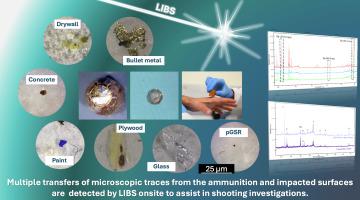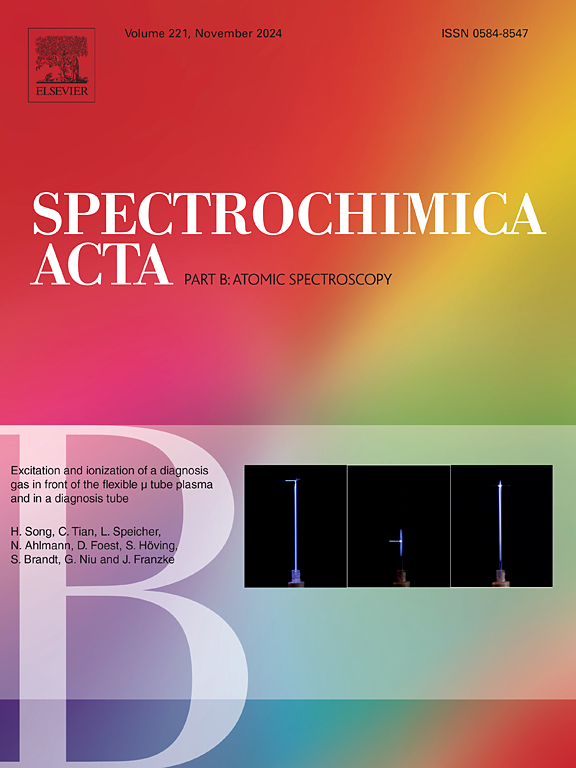推进LIBS移动技术在射击重建和枪支相关调查中的应用
IF 3.8
2区 化学
Q1 SPECTROSCOPY
引用次数: 0
摘要
在枪击事件中,表面之间转移的微观残留物对犯罪现场重建至关重要。在现场识别这些证据是理想的,因为被忽视的项目可能会丢失或变得不可靠。这项概念验证研究表明,移动激光诱导击穿光谱(LIBS)技术为原位增强成像、快速单粒子分析和敏感的多元素检测提供了创新能力。LIBS用于评估枪手的手、撞击表面和其他枪支相关部件的痕量残留物。射击现场常见的八种基材(干墙、涂漆干墙、建筑板玻璃、胶合板、混凝土和汽车挡风玻璃、挡泥板和侧门)使用三种类型的子弹(全金属夹套、夹套空心点和铅圆头)射击,导致穿孔或跳弹。通过微观形貌和发射光谱对转移残留物进行了鉴定。与控制样本的大约2100个光谱比较揭示了在所有实验中射击残留物(GSR)和基材残留物(例如干墙,混凝土和汽车零件)转移到射手手上的多个实例。重复实验的检出率从33%到100%不等,取决于子弹类型、弹道相互作用和底物特性。从枪手的手上和弹孔采集的样本中95%都检测到了火药残留。证明了8种基质中的7种(87.5%)向回收子弹的转移或残留物。观察到金属屑从子弹或弹壳转移到射手的手和弹孔,因子弹类型而异。从GSR、子弹和基材到射手手上的多重残留物转移的证据,以及子弹和基材表面之间的交叉转移,以及使用快速、可靠的技术检测它们的能力,可以大大提高枪支相关调查中法医证据的调查和证明价值。本文章由计算机程序翻译,如有差异,请以英文原文为准。

Advancing the use of LIBS mobile technology in shooting reconstructions and firearm-related investigations
Microscopic residues transferred between surfaces during a shooting event are crucial for crime scene reconstruction. Identifying this evidence on-site is ideal, as overlooked items can be lost or become unreliable. This proof-of-concept study demonstrates that mobile Laser-Induced Breakdown Spectroscopy (LIBS) technology offers innovative capabilities for in-situ enhanced imaging, rapid single-particle analysis, and sensitive multi-elemental detection. LIBS is evaluated for characterizing trace residues from the shooter's hands, impacted surfaces, and other firearm-related components. Eight substrates commonly found at shooting scenes (drywall, painted drywall, architectural sheet glass, plywood, concrete, and vehicle windshield, fender, and side door) are fired at using three types of bullets (full-metal jacket, jacketed hollow point, and lead round nose), resulting in either perforation or ricochet. The transferred residues are identified by their microscopic morphology and emission spectra. Approximately 2100 spectral comparisons with control samples reveal multiple instances of transfer of gunshot residue (GSR) and substrate residues (e.g., drywall, concrete, and automotive parts) onto the shooter's hands across all experiments. Detection rates in replicate experiments varied from 33 % to 100 %, depending on the bullet type, trajectory interactions, and substrate properties. GSR was detected in 95 % of samples collected from the shooter's hands and bullet entry holes. The transfer or residues from seven of the eight substrates (87.5 %) to recovered bullets is demonstrated. The transfers of metal shavings from the bullet or cartridge case to the shooter's hands and bullet hole are observed, varying by bullet type. The evidence of multiple residue transfers from GSR, bullets, and substrates onto a shooter's hand, as well as cross-transfers between bullet and substrate surfaces, and the ability to detect them using rapid, reliable technology can substantially enhance the investigative and probative value of forensic evidence in firearm-related investigations.
求助全文
通过发布文献求助,成功后即可免费获取论文全文。
去求助
来源期刊
CiteScore
6.10
自引率
12.10%
发文量
173
审稿时长
81 days
期刊介绍:
Spectrochimica Acta Part B: Atomic Spectroscopy, is intended for the rapid publication of both original work and reviews in the following fields:
Atomic Emission (AES), Atomic Absorption (AAS) and Atomic Fluorescence (AFS) spectroscopy;
Mass Spectrometry (MS) for inorganic analysis covering Spark Source (SS-MS), Inductively Coupled Plasma (ICP-MS), Glow Discharge (GD-MS), and Secondary Ion Mass Spectrometry (SIMS).
Laser induced atomic spectroscopy for inorganic analysis, including non-linear optical laser spectroscopy, covering Laser Enhanced Ionization (LEI), Laser Induced Fluorescence (LIF), Resonance Ionization Spectroscopy (RIS) and Resonance Ionization Mass Spectrometry (RIMS); Laser Induced Breakdown Spectroscopy (LIBS); Cavity Ringdown Spectroscopy (CRDS), Laser Ablation Inductively Coupled Plasma Atomic Emission Spectroscopy (LA-ICP-AES) and Laser Ablation Inductively Coupled Plasma Mass Spectrometry (LA-ICP-MS).
X-ray spectrometry, X-ray Optics and Microanalysis, including X-ray fluorescence spectrometry (XRF) and related techniques, in particular Total-reflection X-ray Fluorescence Spectrometry (TXRF), and Synchrotron Radiation-excited Total reflection XRF (SR-TXRF).
Manuscripts dealing with (i) fundamentals, (ii) methodology development, (iii)instrumentation, and (iv) applications, can be submitted for publication.

 求助内容:
求助内容: 应助结果提醒方式:
应助结果提醒方式:


